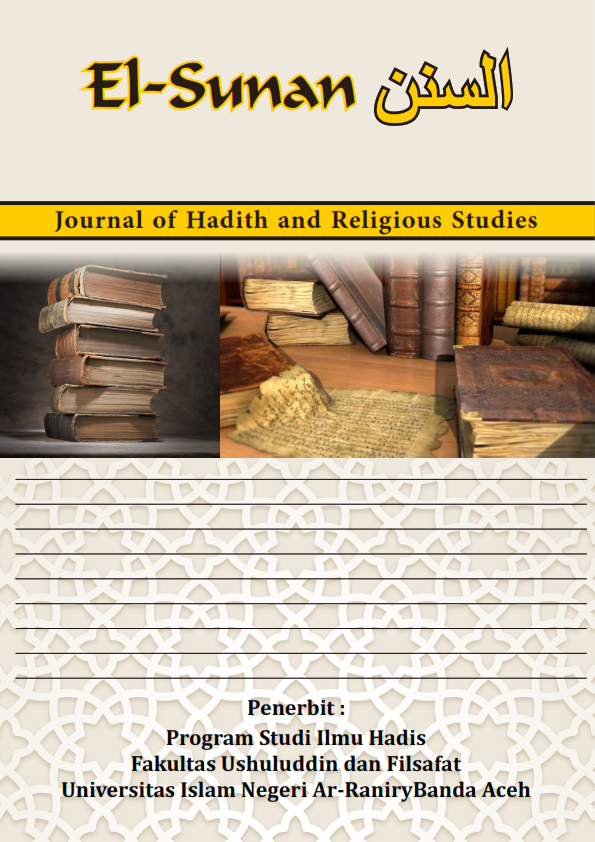Beragam Metode Memahami Hadis Nabi Saw
DOI:
https://doi.org/10.22373/el-sunan.v1i1.3457Keywords:
Metode, Memahami, HadisAbstract
The existence of hadiths has not only colored society in various aspects of life, particularly in the academic world, but has also become a continual and fascinating subject of study and research, including approaches and methodologies for understanding and applying hadiths. Nevertheless, comprehending the meaning of a hadith properly can sometimes be relatively challenging. Therefore, the understanding of hadiths has undergone a very long journey, from the time they were spoken and established by the Prophet Muhammad until the present day. The methods used to understand these hadiths have varied from one period to another. This can be understood as a dynamic in the development of human intellectual insight that never ceases over time. The evolution in the understanding of hadiths is also marked by the emergence of various approaches and methods in line with the changing conditions and situations.
ABSTRAK
Keberadaan hadis tidak hanya telah mewarnai masyarakat dalam berbagai kehidupan, terutama dalam dunia akademisi, akan tetapi juga telah menjadi bahasan dalam kajian dan penelitian yang menarik dan tiada hentinya, termasuk pendekatan dan metodologi pemahaman hadis beserta aplikasinya. Meskipun demikian, untuk memahami maksud suatu hadis secara baik terkadang relative tidak mudah. Oleh karena itu, pemahaman terhadap hadis telah mengalami perjalanan yang sangat panjang, sejak hadis itu diucapkan dan ditetapkan oleh Nabi saw sampai saat sekarang inki. Metode yang digunakan dalam memahami hadis tersebut saling berbeda antara satu periode dengan periode yang lain. Hal ini dapat dimaklumi sebagai suatu dinamika perkembangan wawasan intelektual manusia yang tidak pernah berhenti sepanjang masa. Perkembangan pemahaman terhadap hadis juga ditandai oleh munculnya berbagai pendekatan dan metode sesuai dengan kondisi dan situasi.
References
Abdul Mustaqim, Ilmu Ma’anil Hadits Paradigma Interkoneksi; Berbagai Teori dan Metode Memahami Hadits, (Yogyakarta: Idea Press, 2008).
Arifuddin Ahmad, Memahami Hadis Nabi, ( Cet I; Jakarta: Renaisans, 2005)
Ibnu Abdil Bar, Jami’ Bayan al-‘Ilm wa Fadhiihi, Juz II (Beirut: Dar Al-Fikr, tt)
Ibnu Hajar al-’Asqalani, Bulugh al-Maram, (Surabaya: al-Hidayah, t.th)
Jalal al-Din Al-Suyuthi, al-Jami’ al-Shaghir fi Ahadis al-Basyir wa al-Nadzir, (Surabaya: al-Hidayah, t.th.)
Muhammad ‘Ajaj Al-Khathib. Ushul al-hadis ‘Ulumuhu wa Musthalahuhu, (Beirut: Dar al-Fikr, t.th)
Muhammad Al-Ghazali, Al-Sunnah al-Nabawiyyah Bayna Ahl Al-Fiqh wa Ahl Al-Hadis (Kairo, 1989, buku ini edisi berbahasa Indonesianya diterbitkan Mizan (1999) berjudul Studi Kritis atas Hadis Nabi Saw.: Antara Pemahaman tekstual dan Kontekstual.
Muhammad ibn Idris al-syafi'i, al-Risalah (Naskah diteliti ulang oleh Ahmad Muhammad Syakir), (Beirut:al-Maktabah al-Umamiyah, t.th)
Muhammad ibn Idris al-Syafi'i, al-Umm, Jilid VIII (Beirut:Dar al-Fikr, t.th)
Suhudi Ismail, Kaidah Kesahihan Sanad Hadis (Jakarta: bulan Bintang, 1995)
Suryadi, Metode Pemahaman Hadis Nabi (Telaah Atas Pemikiran Muhammad Al-Ghazali Dan Yusuf Al-Qardhawi). Ringkasan Disertasi, (Yogyakarta: Program Pasca sarjana UIN Sunan Kalijaga, 2004)
Yusuf Qardhawi, Bagaimana Memahami Hadis Nabi SAW, (Bandung: karisma, 1999)
Downloads
Published
How to Cite
Issue
Section
License
- Authors retain copyright and grant the journal right of first publication with the work simultaneously licensed under an Attribution-NonCommercial-ShareAlike 4.0 International (CC BY-NC-SA 4.0) that allows others to share the work with an acknowledgment of the work's authorship and initial publication in this journal.
- Authors are able to enter into separate, additional contractual arrangements for the non-exclusive distribution of the journal's published version of the work (e.g., post it to an institutional repository or publish it in a book), with an acknowledgment of its initial publication in this journal.
- Authors are permitted and encouraged to post their work online (e.g., in institutional repositories or on their website) prior to and during the submission process, as it can lead to productive exchanges, as well as earlier and greater citation of published work.


